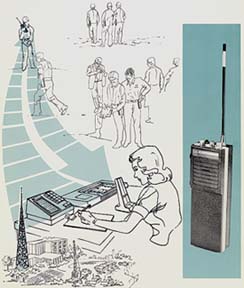
HT-220 Pagehttps://www.mfwright.com/HT220.html(site was at www.batnet.com/mfwright/HT220.html but ISP changed domain to userwebs.batnet.com) hosted by the HT-220 Preservation Society |
HT220s in the movies and TV shows
12-24-17 update: HT220 repair service and HT220s (and the HT200) in the movies but not much updates since years and years ago. In process of updating this site i.e. replacing defunked geocities links. There may be other images missing since the previous batnet domain terminated.
Portable Clinic Products & Services (KA4LMW) offers HT-220 Repair Tuning Services via Ebay for $33 buy-it-now. This is for sending your HT220 in for repair, additional costs for more extensive repairs may be added.
Download PDF copies of HT-220 Preservation Society newsletters here

Back in the 20th century when only women wore earrings and men walked the surface of the Moon, the Motorola HT-220 was the hottest handheld on the market when it was introduced in 1969. Tougher than a pit bull, this VHF or UHF business band handheld in a weatherproof housing was the envy of ham radio operators for its compact size and performance. It contains a very sensitive and selective receiver, and a transmitter that can deliver up to 5 Watts (4 on UHF). It can easily be identified with the silver center band (metal frame) with stellar blue hi-impact plastic front and back. Servicing the HT220 is convenient as the front and back covers can be removed to access component board from both sides.
The HT-220 was the second generation of 2-way FM handheld radio and the successor to Motorola's first business band handheld, the HT-200. Two custom-designed ICs were used in the HT-220 which vastly reduced the number of components and the overall size of the radio from the 200 series. The HT-200, introduced in 1962, circuitry was all discrete components; the HT-200 is big and scary.
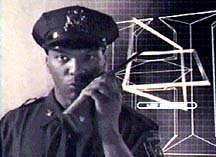
As the years gone by and the HT-220 moved to the pages of history, many of the newer handhelds haven't become smaller or have more transmit power than the HT-220. They have become more sophisticated, and some of the newer radios may have a more selective and sensitive receiver (though many new have taken a downturn in noise rejection). Frequency synthesis and microprocessor chips are the backbone of the new generation of portables which can offer more channel selection and trunking capabilities.
The HT220 was used on The History Channel as part of a annoucement for a program series discussing law enforcement as seen on this video clip. They also occasionally show this same actor portraying historical police officer during station ID breaks.
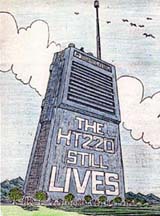
There are some people who refuse to accept that the HT220 has perished. Check out this drawing that somebody sent to this webpage.
In the history of the 220, there should be mention of the HT100, since it was a radio which was a 220 less the power amplifier. You hardly see HT-100's anymore -- they're just too exotic, what with the funny button-cell battery pack, the low, low power (100 mW), etc., but they do surface from time to time. Some people think the HT-100 is a nice radio for local plant operations but others considered it cute but impractical.
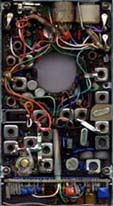
Here is the inside of a HT-220, a VHF with "PL" board. The PL board, sideways, with Vibrasponder is the lower section. Receive crystals (two) are on the right top and the transmitter crystal (one on the upper left, same side as PTT switch). The IF crystal (16.345 MHz) is on the lower right side. Above it and to the right some more, surrounded by rubber, is the crystal filter (16.8 MHz). The UHF model has the same placement except it would have two crystal filters to the right of the IF crystal. These crystals are important in determining if a used HT220 is worth buying. If IF crystal and crystal filters are not there, the value of the radio is very small (in the order of 5 cents). The IF crystal can be purchased for a nominal fee but crystal filters, available from Motorola, are very expensive ($75 each). Plus they are more difficult to install than regular operating crystals (the filters have 3 leads). Note that the operating crystals on this particular unit were crushed to render the radio inoperative on its operating frequency. Being a surplus radio, they wanted to prevent unauthorized people calling up on a public safety agency channel, "breaker, breaker, one-niner!" The radio can re-crystalized and re-tuned for other frequencies (assuming YOU are authorized to transmit on the new channel  ).
).
Important Note on DC Power to HT-220
A good, fully charged battery right off the charger is about 17V. Using a bench supply dictates caution, so +15v max is a safe approach.  NEVER, NEVER reverse the polarity of the power supply! Two common areas to look if the cover fuse is blown is the audio output transistors, and a 10uf polarized cap, Cxxx (P/N TBD) across the +15 buss. If any of these components are shorted, they must be replaced. NOTE: If the audio transistors are blown, it is a good indication that someone applied power with REVERSED polarity.
NEVER, NEVER reverse the polarity of the power supply! Two common areas to look if the cover fuse is blown is the audio output transistors, and a 10uf polarized cap, Cxxx (P/N TBD) across the +15 buss. If any of these components are shorted, they must be replaced. NOTE: If the audio transistors are blown, it is a good indication that someone applied power with REVERSED polarity.
Jerry Zacker sent this article about the HT-220 from a Motorola publication (click the title):
Note there are numerous photos to download.
For more details of the HT-220, click these following pages:
HT-220 Accessories and Batteries
Motorola Parts Identification List
Typical Transmitter Troubleshooting Chart
Typical Receiver Troubleshooting Chart
HT-220 Memories from a Design Team Member
HT-220 Program Design from a Project Member
Working the 'Dream Come True' from a Motorola Technician
Batteries for HT-220 Slimlines
Cleaning HT220 Battery Contacts
White House Secret Service HT-220
Are your ideas here? If not, they could be and other HT-220 enthusiasts can be learning from your contributions! Please send me your tech tips and stories for posting on the HT-220 Page. Let me know if you want your name added to the credits.
Dale has lots of interesting stuff at https://www.wa4dsy.net
Economic Stabilization Program
from 1971 Motorola Communications Buyers Guide
APCO Communications "How Do They Read You?" Etiquette poster
HT-100 info: This corny little spin-off of the HT-220 is also a collectors item
HT-200 info: It's big, it's heavy, and (best of all) it's scary. Predecessor of the HT220.
Scans from a 1978 Motorola Parts & Data Handbook which features:
Motorola Transmitter ID tag, a requirement for your Motrac and Consolette radios.
Here's a blast from the past (Spectronics catalog photo):
Here you will see a young lady with various Moto stuff in her shopping cart including a Motrac, HT-220, HT-200, a Consolette power supply, and she's browsing some tube-type mobile equipment. [use your Back Button to return]
Do you have a question or problem with an HT220 that cannot be solved with the information on this page? Ask Mike Gibbemeyer (K1CW) at Jurypowr @ aol.com. He worked at the Motorola plant performing acceptance tests and servicing of HT220s. If he cannot solve your HT220 problem, then the HT220 probably cannot be fixed.
Places that sell old Motorola radios, accessories, and manuals
Manuals For Sale
Ed Fong has complete, brandnew HT220 manuals in all models A-D. They are $10. His email address is edison_fong @ hotmail.com
Motorola Radios and Accessories for sale by Bob Jarnutowski (click here)
Editor's Note:
MDM Radio Ltd.
1629-B N. 31st Avenue
Melrose Park, IL 60160-1837
Voice (708) 681-0300
Fax (708) 681-9800
email: sales @ mdmradio.com (If using email, please include a phone number.)
https://www.MDMradio.com/
Brinkley Electronics
8411 NC Highway 109
Winston-Salem, NC 27107
Voice (336) 769-2902
Fax (336) 769-4029
email: radios @ rbdc.com
https://www.brinkleyelec.com/
Another source for old HT220 stuff may be at Panik's Electronics N Surplus at https://www.panikelectronics.com
Panik's Electronics alternate website:
https://surfusa.com/panikelectronics.html
Panik's Electronics current inventory
https://www.panikelectronics.com/panik.txt
Panik's Electronics alternate inventory website:
https://surfusa.com/panik.txt
Used radios by TelePath Corp. (https://www.telepathcorp.com)
URLs to Used Equipment by https://dmoz.org
Spantek Radio at https://www.spantekradio.com/ sells lots of used equipment
Occasionally people ask for MT500s and some of the above links may have MT500s. "Radiotrader" (email radiotr @ jaxnet.com) has a collection of MT500 channel elements listed at his webpage here at https://users.leading.net/~radiotr/MT500.
Daryl Jones of Telecommunications Engineering Associates has contributed information to this page. Although he does not have HT220 stuff available, his business has a considerable amount of surplus Motorola base and mobile gear. All this equipment is available for free or very cheap. If you are in the SF Bay Area (San Carlos, California), stop by with a truck. See his webpage at https://www.tcomeng.com.
MT-500 Website
There used to be a webpage dedicated for MT500s at http://www.mt500.com but it is now a MT500 motorcycle page.
HT-220 Manuals Available from Motorola
Motorola still sells (but probably not for long) re-productions from a contractor. They are not *full* re-productions but they have enough for tuning and repairs. Many of the parts listed in the manuals may no longer be available (and the ones that are cost lotsa bux).
Available from the Motorola Accessories and Aftermarkets Product Division
Call 1-800-422-4210
Prices are subject to change.
HT-220 (H33FFN) VHF,
Omni housing Service Manual (shows accessories but does not have complete schematics)
Motorola P/N 68P81001C60-D, $25.00
HT-220 (H33FFN) VHF,
Omni housing Supplement (has schematics)
Motorola P/N 68P81001C63-G, $5.78
HT-220 (H23FFN) VHF,
Slimline housing Supplement (has schematics)
Motorola P/N 68P81001C74, $3.94
HT-220 (H24FFN and H34FFN) UHF,
Slimline and Omni housing Supplement (has schematics)
Motorola P/N 68P81001C83-K, $2.00
Editor's Note:
Motorola has a Part Number Search Engine (click here) that is useful for tracking down various parts that Motorola still sells.
Motorola - CGISS - Accessories & Aftermarket Division, Service Aids at http://ap.cgiss.motorola.com/AAD/portable/lts2000/svc_detail/svc_aids.html
HT220 as a Greatest Gadget
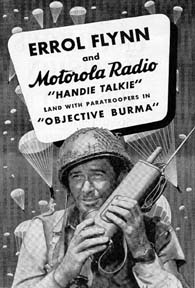
"Handie Talkie," or HT, is a trademark name by Motorola and it supposed to only be used for identifying handhelds by the "Big /\/\" and no one else. How serious is this?  Well, you can be rounded up with the usual group of suspects like those who misuse words like kneenex, band-aid, and xerox!
Well, you can be rounded up with the usual group of suspects like those who misuse words like kneenex, band-aid, and xerox!
The name "Handie Talkie" was used in World War II when Motorola introduced a two-way radio small enough to be carried with one hand, as compared to the GI-styled backmounted radios (Army "breakie backies").
HT-220 Frequency Bands
HT-220 is available as a VHF (136 to 174 MHz) or UHF (406 to 512 MHz). VHF is split into three bands: 136-150.8, 150.8-162, and 162-174 MHz. The 150.8-162 version can be downbanded to the Amateur Radio 2-Meter band by modifying with capacitors.
UHF is split into three bands: 406-420, 450-470, and 470-512 MHz.
Note: No problem bringing a 450-470 HT into ham band (440 MHz). Just retune.
The 470-512 MHz (T-band) version is a later release of the HT-220 when the FCC allocated television channels 14 through 20 frequencies in selected areas to business and public safety agencies.
 ).
).
Selecting frequencies on a HT-220 is not like selecting frequencies on today's handhelds where you punch in the desired frequency on a keypad. The HT-220 has to have a crystal.
The HT-220 is a crystal-controlled radio and requires a crystal for each frequency, one for transmit and another for receive. A 2-channel unit will need another set of crystals. The crystal will have to be changed if a different frequency is desired. This is why the HT-220 is limited to 6-channel maximum because it is size limited to how many crystals it can hold. The transmitter and the receiver will have to be aligned for each frequency by tuning associated components (coils and capacitors).
Unless you are rich and can afford someone else to do the work, you have to get crystals for the HT-220 as they did in the old days, LIKE MEN! This means going to the quarry (hiking 20 miles through the snow even in the summer), bust rocks until you get a adequate amount of quartz to grind the crystals, and then hiking back (it's uphill both ways!) to your shop were you have to spend long endless nights painstaking grinding the quartz to the precise thickness so the crystal vibrates at the exact frequency you want. Kids these days...
Well, it is not this bad. You can order crystals to the desired frequency from either ICM (https://www.icmfg.com or 1-800-725-1426) or Peterson Radio at (712) 323-7539. ICM will calculate the actual crystal frequency for the operating frequency you specify for the HT-220. Cost is typically $15 and delivery is about 2 weeks. After soldering the crystal in place, you still need to tune the radio for optimum performance.
Now you may be asking "ain't this the same techniques Guglielmo Marconi and Charles Herrold used on their radios?" This is why the current market price of the HT-220 is so cheap. You must be technically competent in RF circuitry, and willing to put in the effort to make it operational (most people will not). Tools required are a finetip soldering station, needle-nose pliers, small snips, tuning tools, and test equipment. Other things such as de-soldering tools (if removing old crystals) and a test jig (recommended) to hold the chassis in place during servicing.
Some years ago, the FCC regulations stated that radio transmitters may be tuned or adjusted only by persons holding appropriate commercial radiotelephone operator's license. The purpose was to prevent mal-adjusted radios from technically incompetent people going on the air. But these days, brain dead people can perform whatever is required for adjustments outside the factory since virtually all 2-way radios are computer-programmable and have no servicable parts. However, an FCC license is still required for servicing aircraft and marine radios.
HT-220 Prices
 It has been mentioned that the current market rate of HT-220s are $10 per pound ("they make excellent doorstops!") Typical prices range from $10 to $30 for both working and non-working. Sometimes the cost can go higher if it comes with a charger, battery, and/or antenna. And other factors such as number of channels, PL, special model, etc. Price usually depends on how fast the seller wants to unload it or if the buyer is fiercely determined to get a "police styled" radio like what Kojak used (as shown in photo on right). Anything more than $40 is way too much. $30 should be considered the top price of an HT220.
It has been mentioned that the current market rate of HT-220s are $10 per pound ("they make excellent doorstops!") Typical prices range from $10 to $30 for both working and non-working. Sometimes the cost can go higher if it comes with a charger, battery, and/or antenna. And other factors such as number of channels, PL, special model, etc. Price usually depends on how fast the seller wants to unload it or if the buyer is fiercely determined to get a "police styled" radio like what Kojak used (as shown in photo on right). Anything more than $40 is way too much. $30 should be considered the top price of an HT220.
 Editor's note: I don't have a photo of Angie Dickinson with an HT220 but here she is with a Mocom70 in the television series "Police Woman."
Editor's note: I don't have a photo of Angie Dickinson with an HT220 but here she is with a Mocom70 in the television series "Police Woman."
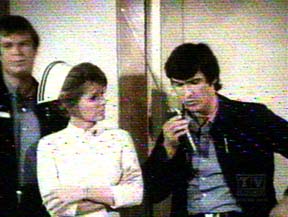 Something uncommon on the TV series "Emergency," Randolph Mantooth with an HT-220 (normally they use some big ugly handheld). Julie London, top nurse of Rampart (also the beautiful singer of the 1950s) looks on. (editors note: It seems the antenna is too long instead of the 18 inches for VHF, maybe the HT is something else.
Something uncommon on the TV series "Emergency," Randolph Mantooth with an HT-220 (normally they use some big ugly handheld). Julie London, top nurse of Rampart (also the beautiful singer of the 1950s) looks on. (editors note: It seems the antenna is too long instead of the 18 inches for VHF, maybe the HT is something else.
(OK, back to pricing info)
Because prices are so depressed for any denomination of the HT220, many of them are simply being tossed out than presented on the used equipment lists by commercial vendors. Hamfests routinely include large boxes of old Motorola portable parts, with the HT-220s at the dirtiest bottom of the pile.
"How does a radio that sold for big $$$$ go for so cheep these days?"
Way back in the days of polyester clothes (the 1970s) the HT-220 price tag was $600 to $1400 (that's 70s dollars). It's a different world today and with programmable radios, nobody has a use for HT-220s, except for specific hobbyists. Most amateur radio operators carry programmable handhelds. Radios (exception CBs and cellphones) purchased new from Motorola are such that if you have to ask the price, you can't afford it.
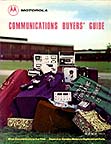 The one old Motorola item that has become very difficult to obtain are the books they use to give out for free in the 1970s. These are the Communications Buyers Guide and the Parts and Data Handbook. Excellent resource for reference for all the great "boatanchors" and "doorstops."
The one old Motorola item that has become very difficult to obtain are the books they use to give out for free in the 1970s. These are the Communications Buyers Guide and the Parts and Data Handbook. Excellent resource for reference for all the great "boatanchors" and "doorstops."
HT-220 Rear Photos With Cover Removed
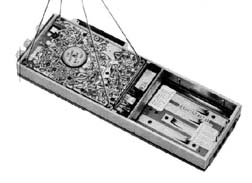
This photo shows the side and back of a Slimline version. This is the solder side of board and also shown is the "PL" board is between the main board and battery compartment.
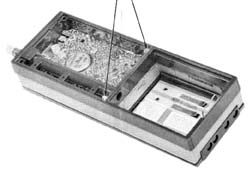
This photo shows the side and rear of a Omni-housing version. Notice the frame extension and extra room to put a high power PA board and the multi-channel board (3 or more freq).
HT-220 Cleaning
Here's a cleaning tip contributed by Ed Fong:
HT-220 Wire Placement
"There I was... thought I was gonna die!" is the thought HT-220 novices had when they removed the front cover and pulled the 4 wires connecting it to the main component board, and forgot to note where the wires go. Well don't fret because two diagrams (normally on the inside rear cover) shows the wire placement. Also shows the metering points used for alignment.
The four wires (red, black, white, blue) connect on the component side of board. The following images are the solder side of board.
HT-220 Private-Line Squelch
You get no privacy from "Private-Line." This is a trademark by Motorola for their name of the tone-coded squelch feature (CTCSS). Click here for Motorola Private Line Codes
HT-220 and MT-500 Antenna Cross Reference Chart
Antenna Color Coding
(paint dot found on thread of antenna)
courtesy of the old www.mt500.com before the motorcycle
Part Number
85-05195H01
85-05195H02
85-05195H03
85-05195H0485-82283J05
85-82283J06
85-82283J01
85-82283J0285-05146B03
85-05146B04
85-05146B05Model
NAB6001
NAB6002
NAB6003
NAB6004NAD6221
NAD6222
NAD6219
NAD6220NAE6100
NAE6142
NAE6163Frequency
30-35
36-40
40-45
46-50136-142
142-150.8
150.8-162
162-174406-420
440-470
470-512Color
Yellow
Green
Black
BlueYellow
Green
Black
BlueRed
Green
Black
Editor's Note:
Motorola Search Query at https://search.motorola.com/.
There is a page of current Motorola portables accessories somewhere at https://AccessSecure.mot.com I used to have a direct link but they keep changing the URL.
Motorola has a Part Number Search Engine (click here) that is useful for tracking down various parts that Motorola still sells.
BatLabs at https://www.batlabs.com has lots of information on Moto stuff though primarily on radios much newer than HT220.
Motorola Model Numbers circa 1976 by http://www.batlabs.com.
Motorola NSO Service Parts at https://www.arsradio.com/480/service_parts.htm.
In November 2000, FCC authorized MURS (Multi-Use Radio System) at 151.82, 151.88, 151.94, 154.57 and 154.60 for up to 2 W on an unlicensed basis under Part 95 of the FCC's rules. The FCC said it will "revisit" the issue of allocating additional MURS channels "at a later date should additional support develop." Also note that 154.6 MHz is used by McDonalds Hamburgers for one of the drive-up channels.
 Editors Note: Please be advised that operating a 1.8 watt HT220 may not be valid on MURS. There are limitations such as bandwidth of 2.5KHz so HT220 will have to be adjusted accordingly.
Editors Note: Please be advised that operating a 1.8 watt HT220 may not be valid on MURS. There are limitations such as bandwidth of 2.5KHz so HT220 will have to be adjusted accordingly.
 It should be noted you can modify "accepted equipment" (i.e.) for business bands such as the HT220 to operate on amateur radio bands, however, you cannot operate a amateur radio on business bands (amateur gear is not considered "accepted equipment").
It should be noted you can modify "accepted equipment" (i.e.) for business bands such as the HT220 to operate on amateur radio bands, however, you cannot operate a amateur radio on business bands (amateur gear is not considered "accepted equipment").
For more on MURS, visit the MURS Homepage at https://www.provide.net/~prsg/murshome.htm which includes opeating rules, FAQ, and latest developments. This webpage does not have rotating banners, javascript or any other worthless "hubcaps" to screw-up your browser.
Reaction of seeing someone with an HT-220:
If you think the HT220 is an old radio, take a look at this page on a Motorola "Handie Talkie" from the days when ships were wood and men were steel.
This website is for noncommercial purposes only. This is not an official media outlet for Motorola, nor is it for any organization. I make no claims to technical accuracies. USE AT OWN RISK. Every effort has been made to make this article to be non-offensive and politically correct. I receive no compensation for this site.
This web site was constructed as a contribution for radio hobbyists to assist them in restoring older style radios.
 WARNING: FCC license required for transmitting on frequencies covered by the HT-220.
WARNING: FCC license required for transmitting on frequencies covered by the HT-220.
 NOTICE: HT-220 cannot be certificated for transmitting in the Family Radio Service (FRS) bands.
NOTICE: HT-220 cannot be certificated for transmitting in the Family Radio Service (FRS) bands.
 WARNING: Amateur radio license is required for tuning, adjusting, and operating transmitters on the Amateur radio bands.
WARNING: Amateur radio license is required for tuning, adjusting, and operating transmitters on the Amateur radio bands.
Michael Wright, K6MFW
Website Editor